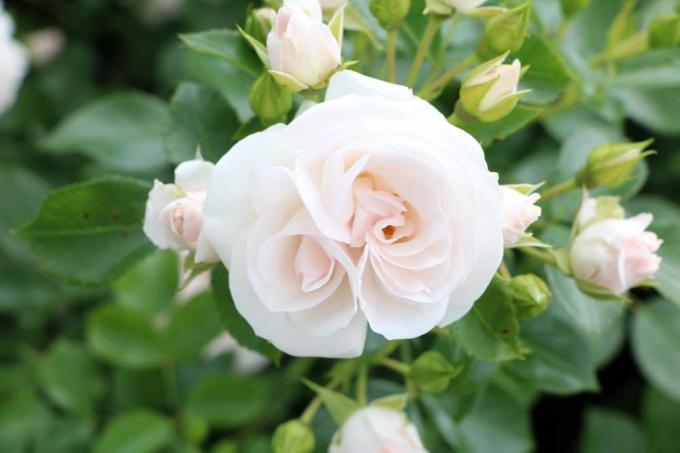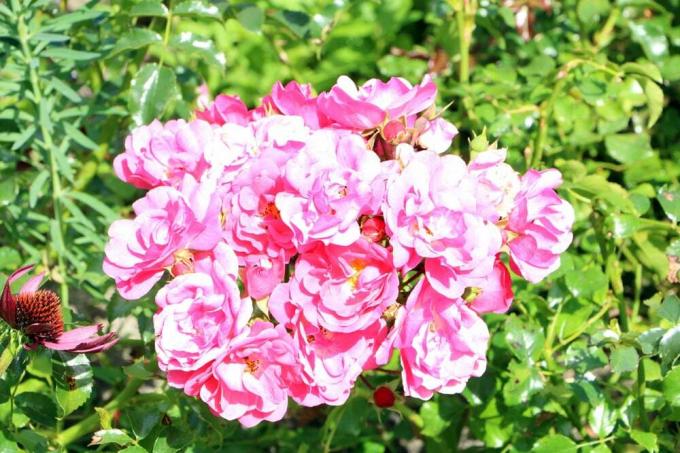

Table of contents
- types of roses
- harvest time
- Bunch of flowers
- Split off
- drying
- book drying
- free drying
- dry salt/silica gel and detergent
- oven drying
- microwave drying
- durability
- Conclusion
Properly dried and preserved for a long time, you can enjoy rose petals and rose blossoms for many years. The basis is optimal drying. In order to preserve the fragrance and the color in the long term, you have various options within the scope of preservation. To do this, you need simple tools that are available in almost every well-equipped household, as well as a little patience. The following guide explains in detail how you should proceed and which methods are available to you.
types of roses
All types of roses are suitable for giving rose petals and/or rose blossoms an immortality by drying them. Here the skill lies above all in the right time when the leaves or flowers are removed. If the scent of roses is to fill the environment in the long term, it is advisable to only select rose varieties with a strong scent. These include, for example:
- Shrub rose 'Rhapsody in Blue'
- Bed rose "Sunlight Romantika"
- Small shrub rose 'Pink Roadrunner'
- Portland Rose 'Rose de Resht'
- Rosa rugosa "Agnes"
harvest time
If you have your own stock of roses in your garden, you are of course tied to the flowering time when harvesting the leaves and flowers. As a rule, most rose varieties start in June, although there are also some that get their first main bloom as early as May or as late as July. In order not to deprive the garden of the optical splendor of blooming roses, you should take a look at the blossoms every day, especially on hot and/or rainy days. This is the only way you can take fresh, fragrant and intensely colored flowers from the rose in good time before the withering phase begins.
It is advisable not to wait for the leaves or entire flowers to fall off, but to wait for the exact moment and harvest them while they are still attached to the plant. You should also never pull the leaves before the flower opens, as this usually means that the rose will not sprout any more shoots or buds that year.
If you find a bud that has been in the bud stage for three or four days, it's the perfect time to harvest. This should always be done shortly before full flowering.
Bunch of flowers

If you want to use the blossoms of a rose from a purchased bouquet, these are usually a little open. Since they wither faster than planted in soil, you should start cutting them off after two days at the latest in order to be able to cut them off just before the flowers are fully open.
Split off
Don't just tear off the leaves or whole flowers, cut them. If an entire branch is to be dried, it is cut off above the second leaf base. The prerequisite is that there are no other buds on this branch, which would then die when closed. If only the rose petals or the flower are needed, the flower stalk is cut off directly under the flower. Each petal can then be detached directly from the flower.
drying
In order to make the leaves of roses last for a long time, this requires proper drying. You have various options for doing this:
book drying
Probably the most well-known variant of drying rose petals is with the book. They are placed between the book pages and the book is then closed. It is important here that either a clean, absorbent kitchen paper or, even better, a piece of blotting paper is placed under and over the sheet. This allows the moisture to escape optimally from the leaves and also does not soil the book pages.
But beware:
The sheets must not lie on top of each other.
The absorbent paper should be changed or the sheets shifted in position once a week. After about three weeks, the rose petal should be dry at room temperature. This drying method has the advantage that the rose petals are dried on both sides at the same time.
However, they lose their natural curves and come out completely flattened after drying. For this reason, this process is more suitable, for example, for decorating letters with roses or for picture frames. The same applies to drying flowers.
free drying
In order to retain the individual shape or curvature, drying without pressing is recommended. To do this, the rose petals and/or blossoms are distributed either on a grid or on kitchen paper so that they do not overlap. The cooler the ambient temperature, the slower they dry. The best places are, for example, the boiler room or a sheltered place in the sun on the terrace or balcony.

If paper is used to absorb moisture, it must be replaced every three days or to relocate the material to be dried so that there is full absorbency again and no mold forms.
With lattice drying, air circulates underneath so that no mold can develop. With either method, the rose petals and petals should be turned regularly. This allows them to dry evenly from both sides. In warm temperatures, a turn is possible after about three or four hours.
Tip:
Since all kinds of crawling insects are often taken with the harvest, it is advisable to collect the rose petals in an airtight bag before drying. After a few minutes, you open the bag again and you can see how the crawlers run away as they spill the flowers.
dry salt/silica gel and detergent
Instead of blotting paper, newspaper and kitchen paper, you can also use special dry salt, silica gel or dry detergent. Silica gel is a crystal-like bead packaged in small sachets, often found in shoe boxes or on leather clothing to protect against moisture.
The advantage of this drying process is that it usually dries faster because it specifically extracts the moisture from the rose blossom or leaf. In addition, it can be used several times, allows the original deformation to remain and at the same time has an improved durability.
Depending on the amount of queen flowers and leaves to be dried, a closable container is selected for drying and the bottom is covered with the dry salt or the silica gel. The flower parts are laid out on top and covered with another layer of salt or silica gel. The vessel is then sealed for about three to four days.

With the dry salt variant, you can optimally see how the moisture is absorbed in it, as the salt increasingly takes on the color of the leaves. If the color contrast remains the same, the drying process is complete and the container can be opened.
Tip:
You can quickly dry the dry salt and the silica gel for the next use. Put the salt in the microwave and the silica gel dries in a hot oven in a few minutes.
oven drying
A quick and highly recommended drying method is the oven technique. To do this, the baking sheet is sprinkled with sand, after which you spread the petals and then put the baking sheet in the oven at 40 degrees. After about 30 minutes, the drying process should be over.
The advantage of drying in the oven is not only the time and effort saved, but also because of the quick drying, the petals on the bulb also bulge. This offers a chic look, especially when used as potpourri, and underlines the naturalness. In addition, the minimal heat protects the fragrance aroma and remains much more intense in the dry substance.
microwave drying
You can achieve similar results with drying using a microwave. In addition to the rose parts and a microwave oven, you will need the following accessories:
- Absorbent kitchen paper
- Two microwaveable plates
- Alternatively: two refractory ceramic tiles
Directions:
- Cover/lay out the tile or plate with a layer of kitchen paper
- Distribute rose petals and rose flower heads if necessary
- Put a layer of kitchen paper on top
- Cover with the second plate or tile
- Put in the microwave
- Depending on the wattage, heat between 40 seconds and 1.5 minutes
- Take it out and the drying is done!
- Rose bouquet drying
Not only the rose blossoms and leaves can be dried, but also entire bouquets of roses. The best are those that were cut early and where the flowers have only just opened slightly. Cut the stems diagonally and place the bouquet of roses in a vase of fresh water mixed with glycerine in a 1:1 ratio. You can get glycerine in any pharmacy.

After about two days, take the bouquet of roses out of the water, divide them up to a maximum of eight stems and join them into a bundle. With more rose stems, drying would prove more difficult and an even and complete loss of moisture would not be guaranteed.
Now hang the individual bundles upside down. A cool, dry and airy place should be chosen as the drying location. Storage floors or a barn where no sun shines on the bunches of roses are ideal for this.
Depending on the type of rose and the size of the flowers, the drying time is between four and six days. After that, the bundles can be removed and placed individually or together again in a flower vase without water. Complete drying is completed after around four weeks.
durability
Rose petals and rose blossoms as well as bouquets have a significantly longer lifespan if they are given some kind of preservation. This can be done either with clear coat or with hairspray. Simply spray this on after the drying process is complete. Make sure that you cover everything well with the clear coat or hairspray in order to be able to put an even film on the blossoms, leaves or the entire bouquet of roses.
Both variants give about the same durability, although gloss clear coat can also add a slightly shimmering brilliance. If you repeat the preservation every few months, the dried roses will retain their beauty for years at best. Incidentally, extending the shelf life with hairspray has no effect.
The smell of the spray will only spread in the first few hours after spraying, but the scent of roses will prevail.
Conclusion
Rose petals, rose blossoms and rose bouquets can be dried professionally with the simplest of means without much effort. With the drying methods described here and how to preserve them, you can use the queen of flowers for numerous decorative purposes and as a fragrance oasis in the long term.
 garden editorial
garden editorial I write about everything that interests me in my garden.
Learn more about types of roses

Pruning wild roses: 6 tips for trimming wild roses
Wild roses should not be missing in any natural garden. They are easy to care for and bloom on two-year-old wood. The delicate blossoms and autumnal rosehips enchant the garden well into winter. To maintain their beauty, however, some maintenance is necessary.

18 historical roses with picture | Varieties of roses for the home garden
Creating a rose garden is not as easy as you might think. The gardener often only becomes aware of the variety of different flower colors on the market when the purchase decision is imminent. So that the selection does not have to be made spontaneously and that it takes into account both the appearance and the location requirements can be optimally adapted to the circumstances of his garden, he will find an overview of 18 historical ones here varieties of roses.

Moss rose (Rosa centifolia var. muscosa): care from A to Z
The moss rose (Rosa centifolia var. Muscosa) is a profusely flowering old rose variety that resulted from a bud mutation. The special thing about her is the green to brownish moss on the buds, sepals and flower stalks and their sweet, slightly resinous scent.

Making roses winter-proof: fleece, bark mulch & Co | Ideal time
Roses depend on good winter protection so that the royal blooms can be repeated next year. The focus is on specific precautions for the crown, trunk and roots, tailored to the respective rose type. This guide gives a practical explanation of when and how to best winterize your roses.

Create a rose bed: easy to care for with roses, perennials and stones
The rose is not considered the queen of flowers for nothing. Her beauty is simply incomparable. It goes without saying that under these conditions it belongs in every garden. Here you can learn how to properly plant a rose bed and properly care for the royal plants.

Tub roses: rose care in the pot | Repot roses properly
In the summer months, the balcony and terrace can be embellished with blooming roses, as these flowers can also be planted in tubs. However, due to the deep roots, there are some important factors to consider when choosing the planter, location, care and repotting.



